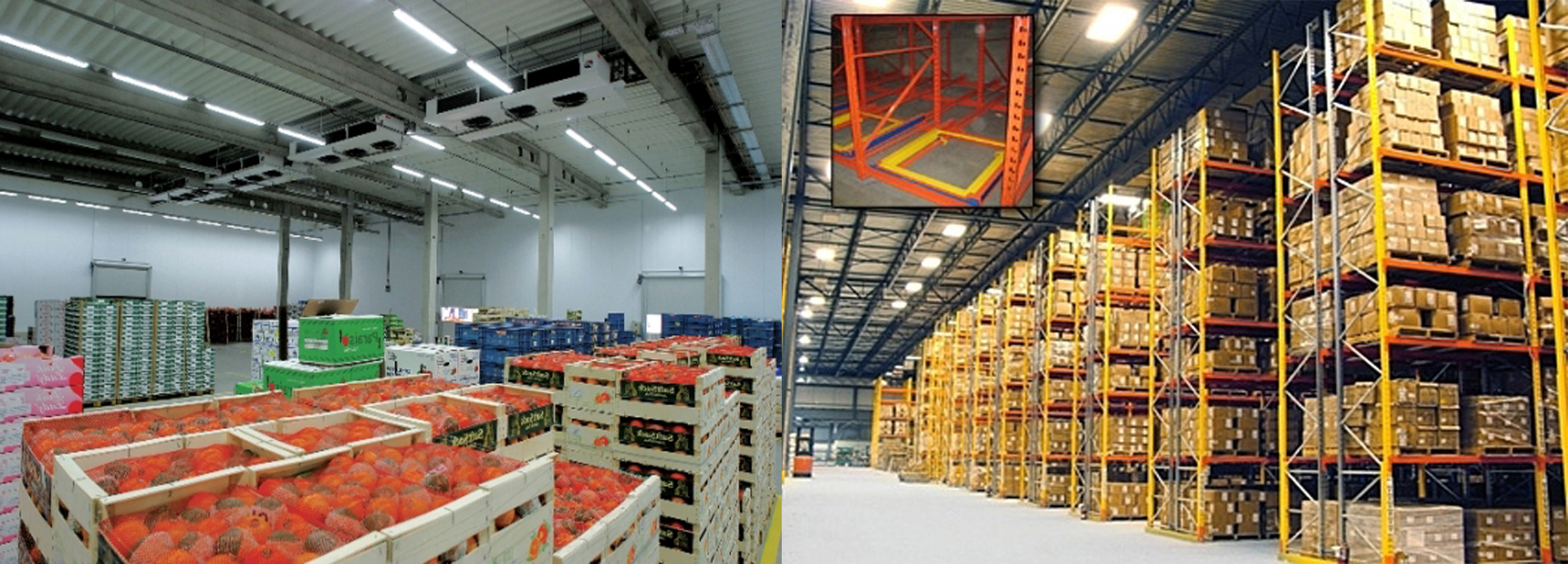
სასაწყობე და სამაცივრე მეურნეობა
საწყობი მიწოდების ჯაჭვის ძალიან მნიშვნელოვანი ნაწილია, ვინაიდან აქ კომპანიის სამუშაო კაპიტალის და მატერიალური ფასეულობების ყველაზე მსუყე წილი გროვდება. შეიძლება ითქვას, რომ ის ისევე მნიშვნელოვანია, როგორც საცავი ბანკში. ამის მიუხედავად, საწყობი მენეჯმენტის მხრიდან იგი ხშირად უყურადღებადა მიტოვებული და მიწოდების ჯაჭვის ერთ-ერთი შუალედური რგოლად განიხილება, რადგან, როგორ წესი, საქონლის დამატებულ ღირებულებას (Value Added) უშუალოდ არ ქმნის.
- რატომ ვიყენებთ საწყობს, რა არის მისი უმთავრესი დანიშნულება?
- რა არის საწყობის ძირითადი ფუნქციები?
რატომ გვაქვს საწყობი
საწყობის არსებობას ორი მნიშვნელოვანი საჭიროება განაპირობებს:
- შენახვის საჭიროება - ძალიან ხშირად საქონელზე მოთხოვნა და მიწოდება ერთმანეთს დროსა და სივრცეში არ ემთხვევა. საწყობი ამ დროს ერთგვარი ბუფერის როლს ასრულებს და გაუთვალისწინებელი მოთხოვნისათვის საქონელს ინახავს.
- კონსოლიდაციის საჭიროება - როგორც წესი საქონლის კონსოლიდაცია (ანუ დიდი რაოდენობით შეკვეთა) დაზოგვის საშუალებას იძლევა: დამატებითი ფასდაკლების მიღების გზით და ასევე ერთ ერთეულზე ტრანსპორტირების უფრო დაბალი ღირებულების გზით. აქ საწყობი ნახევარგამტარის ფუნქციას კისრულობს.
კომპანიას, საჭიროებებიდან გამომდინარე, შეიძლება რამდენიმე საწყობი ჰქონდეს. ქვემოთ ჩამოთვლილია საწყობის ძირითადი ტიპები მოკლე აღწერილობით:
- ნედლეულის შეასანახი საწყობი - ნედლეულისა თუ ნაწილების შესანახად. განლაგებულია საწარმოსთან ახლოს.
- წარმოების პროცესში (Work-in-Progress, WIP) არსებული საქონლის საწყობი- ნაწილობრივ დასრულებული ნაკეთობებისა და კომპონენტების შესანახად. განლაგებულია საწარმოშივე (ან საწარმოსთან ახლოს).
- დასრულებული საქონლის საწყობი - აქ მზა პროდუქცია ინახება. განლაგებულია საწარმოსთან ახლოს.
- შეკვეთების შესრულების ცენტრი - გამოიყენება საქონლის შესანახად და მცირე ზომის შეკვეთების (მაგლითად ონლაინ მაღაზიების შეკვეთების) შესასრულებლად.
- სადისტრიბუციო ცენტრი - აგროვებს და კონსოლიდაცას უკეთებს საქონელს სხვადასხვა მომწოდებლებისაგან და დიდი პარტიებით ერთიანად აგზავნის კლიენტებთან, როგორც წესი - დიდ მაღაზიებსა და სუპერმარკეტების ქსელებში.
- მიქსინგ ცენტრი - სადისტრიბუციო ცენტრსის მსგავსი საწყობი, მაგრამ მისგან განსხვავებით საქონლის გადაწყობას არ აკეთებს, ანუ იღებს და გასცემს საქონელს პალეტებით მათი დაშლისა და ხელახალი შეფუთვის გარეშე.
- ლოკალური საწყობი - განლაგებულია მომხმარებლებთან ახლოს, რათა უზრუნველყოს საქონლის მოთხოვნაზე მყისიერი რეაგირება და ოპერატიული მიწოდება.
საყურადღებოა, რომ რაც უფრო მცირე ადგილი აქვს საწყობს, როგორც წესი მით უფრო მეტი დროა საჭირო საქონლის მისაღებად და გასაცემად და პირიქით. კომპანიის ბიზნესის მოდელის შესაბამისად, მიწოდების ჯაჭვის მოთოვნებიდან გამომდინარე ლოგისტიკოსები იღებენ გადაწყვეტილებას, ამ ორი კომპონენტიდან პრიორიტეტი რომელს მიანიჭონ .
საწყობის ძირითადი ფუნქციები
ნებისმიერი ადგილი, რომელიც ნივთების შესანახად გამოიყენება, არსით საწყობს წარმოადგენს - დაწყებული თქვენი მაცივრით და დამთავრებული ამაზონის უზარმაზარი სადიტრიბუციო ცენტრებით. საწყობის უამრავი ფორმა და კონფიგურაცია არსებობს.
საწყობის საქმიანობა უშუალოდ საქონლის შენახვის გარდა 4 ძირითად ფუნციას მოიცავს:
1. ტვირთის მიღება
საქონლის მიღება საწყობის უპირველესი ფუნქციაა. იგი ჩვენს ყველა მომდევნო ნაბიჯს განსაზღვრავს. მიღების ფუნქციის ოპტიმიზაციის მრავალფეროვანი პრაქტიკა არსებობს, მაგალითად:
- მოსაწოდებელი ტვირთის შესახებ წინასწარი მონაცემების (ASN) მიღება;
- საწყობის რესურსებისა (სასაწყობე ტექნიკა, მუშები ა.შ) და სატვირთო ტრასნპორტის სინქრონიზაცია, რათა რამდენიმე ტრანსპორტის ერთდოულად მოსვლა და რიგში დგომა თავიდან ავიცილოთ;
- ტვირთის მიღებისთანავე გასაცემად გამზადება, თუ იგი უახლოეს მომავლში უნდა გაიგზავნოს;
- ტვირთის ეტიკეტებისა და ლეიბლების მიმაგრება და სხვა.
2. ტვირთის განთავსება
ეს ფუნქცია მიღებული ტვირთის შენახვის შესაბამის ადგილებში განთავსებას გულისხმობს. ეფექტური განთავსებისათვის ტვირთის შესახებ სხვადასხვა ინფორმაცია გვჭირდება: რაოდენობა, ზომები, წონა, არსებული და მოსალოდნელი შეკვეთების სტატუსი და სხვა. ძირითადად განთავსების სამ მეთოდს იყენებენ:
- წინასწარ განსაზღვრული (Directed) განთავსება - ტვირთის შენახვის ადგილი მიღებამდე არის შერჩეული;
- დანაწევრებული და მიმდევრობითი (Batched & Sequenced) განთავსება - ტვრითის მიღების მერე ხდება მისი დახარისხება და ანალოგიურ საქონელთან განაწილება;
- ქაოტური (Chaotic) განთავსება - ტვირთს უსისტემო დალაგება პირველივე შესაფერის ადგილას და შემდეგ ადგილმდებარეობის აღრიცხვა (ასეთ განთავსებას თავის ზოგიერთ საწყობში Amazon-ი იყენებს - დეტალები ჩემს ერთ-ერთ წინა პოსტში იხილეთ).
როგორც წესი, საწყობის შიდა განლაგება მორგებულია ტვირთის ნაკადების მოძრაობაზე, ამიტომაც პოპულარული ნივთები მისაღებსა და გასაცემ პუნქტებთან ყველაზე ახლოს არის ხოლმე განთავსებული. ამ ადგილების იდენტიფიცირება შემდეგი ფორმულით ხდება:
Min(C*Σi(Ni*Di))
სადაც:
i - საწყობში ტვირთის შესანახი ლოკაცია.
C - შრომის ღირებულება მანძილიზე გადაანგარიშებით.
Di - მანძილი მიმღებ პუნტსა, i ლოკაციასა და გამცემ პუნქტს შორის.
Ni - i ლოკაციასთან ვიზიტების წლიური სიხშირე.
თუ უფრო მარტივი ხერხი გვინდა გამოვიყენოთ, მაშინ შეიძლება ამ ალგორითმს მივსდიოთ:
- დავახარისხოთ ყველა ლოკაცია Di მონაცემის მიხედვით - კლებიდან ზრდისაკენ;
- დავახარისხოთ ყველა საქონელი Ni მონაცემის მიხედვით - ზრდიდან კლებისაკენ;
- ყველაზე მაღალი Ni მონაცემის მქონე საქონელი მოვათავსოთ ყველაზე დაბალი Di მონაცემის მქონე ლოკაციაში; შემდეგი ყველაზე მაღალი - შემდეგ ყველაზე დაბალში და ა.შ.
არჩეული სტრატეგიის მიუხედავად, განთავსების ეფექტური ორგანიზება სპეციალურ პროგრამას - Warehouse Management System (WMS) საჭიროებს, რადგანაც ზემოთ აღნიშნული მონაცემები სწორედ მასში ინახება და მუშავდება. WMS სისტემებზე ცალკე პოსტში ვისაუბრებთ.
3. ტვირთის მოგროვება
შეკვეთილი ტვირთის მოგროვება საწყობში ყველაზე შრომატევადი საქმეა. მოგროვების სტრატეგია ტვირთის ზომის შესაბამისად იცვლება, მაგალითად მთლიანი პალეტების სწრაფი მოგროვება ყველაზე მარტივია, ხოლო ინდივიდუალური შეფუთვების მოგროვება ძნელი და ხანგრძლივი პროცესია.
დიდი ზომის საწყობებში ძალიან დიდი დრო ლოკაციამდე მანძილის გავლაში იხარჯება, ამიტომაც მნიშვნელოვანია ლოკაციებს შორის კორიდორების სწორად გაკეთება. როგორც წესი, ტვირთის ნაკადებმა ერთმანეთი რომ არ შეაფერხონ, კორიდორებიც მათ პარალელურად არის მოწყობილი. კორიდორები შეიძლება ერთმანეთის პარალელური, მართობული ან დიაგონალური განლაგებისაც იყოს. მთავარია, რომ ისინი ერგებოდეს საწყობში ტვირთის მოძრაობას (იხ. მაგალითები)
ტვირთის მოგროვების სამი ძირითადი სტრატეგია არსებობს:
- ერთი შემგროვებელი - ერთი შეკვეთა. ერთი ადამიანი აგროვებს ერთ შეკვეთას სხვადასხვა ლოკაციებიდან. ეს მეთოდი კარგია პატარა საწყობებსა და ცოტა შეკვეთების დროს.
- ერთი შემგროვებელი - რამდენიმე შეკვეთა. ერთი ადამიანი აჯგუფებს რამდენიმე შეკვეთას და შემდეგ აგროვებს სხვადასხვა ლოკაციებიდან. ეს მეთოდი მოსახერხებელია როდესაც შეკვეთების მეტ-ნაკლებად დიდი რაოდენობაა და მათში პროდუქტები ხშირად მეორდება, თუმცა იგი დამატებით ძალისხმევას საჭიროებს ერთად მოგროვებული საქონლის სვადასხვა შეკვეთებისათვის დასახარისხებლად.
- რამდენიმე შემგროვებელი - რამდენიმე შეკვეთა. შემოსული შეკვეთები ჯგუფდება საქონლის მიხედვით და შემდეგ ნაწილდება რამდენიმე ადამიანზე, რომლებიც მიმაგრებული არიან თავ-თავიანთ ლოკაციებზე. ეს მეთოდი გამოიყენება დიდი რაოდენობის შეკვეთების დროს, რათა შეკვეთების შეგროვების საშუალო დრო შემცირდეს, თუმცა უზარმაზარი მნიშვნელობა ენიჭება მოგროვებული საქონლის სორტირებას შეკვეთების მიხედვით. ასევე საკმაო სირთულეს წარმოადგენს სამუშაო დატვირთვის ლოკაციების ზონების მიხედვით თანაბრად განაწილება.
არსებობს მეოთხე, შედარებით ახალი მეთოდიც, როდესაც საქონლის სტელაჟები სპეციალური რობოტების მეშვეობით “თვითონ მოდიან” შემგროვებელთან და მან უბრალოდ საჭირო ნივთი უნდა აიღოს. ეს ტექნოლოგია დიდ დანახარჯებს მოითხოვს, ამიტომაც მისი ეფექტურობა მხოლოდ ძალიან მაღალი ბრუნვის მქონე უზარმაზარ საწყობებში ვლინდება. ამ სისტემას წარმატებით იყენებენ ისეთი გიგანტები, როგოიცაა Amazon და Alibaba. აქ და აქ შეგიძლიათ ნახოთ თუ როგორ მუშაობს ეს სისტემა ამ კომპანიებში.
4. ტვირთის შემოწმება, შეფუთვა და გაგზავნა
ბოლო ეტაპზე ხდება შეკვეთების შემოწმება - რაც სატრანსპორტო საბუთების შექმნასა და დამოწმებას, ასევე ზომისა და წონის დადგენას; შეფუთვა - რაც გულისხმობს პალეტების შეფუთვასა და უსაფრთხო ტრანპოსტირების უზრუნველყოფას; მომხმარებელთან გაგზავნა - ეს პროცესი ზემოთ განხილული ტვირთის მიღების სარკისებრი ანარეკლია და შესაბამისად ისეთივე მენეჯმენტს საჭიროებს.
